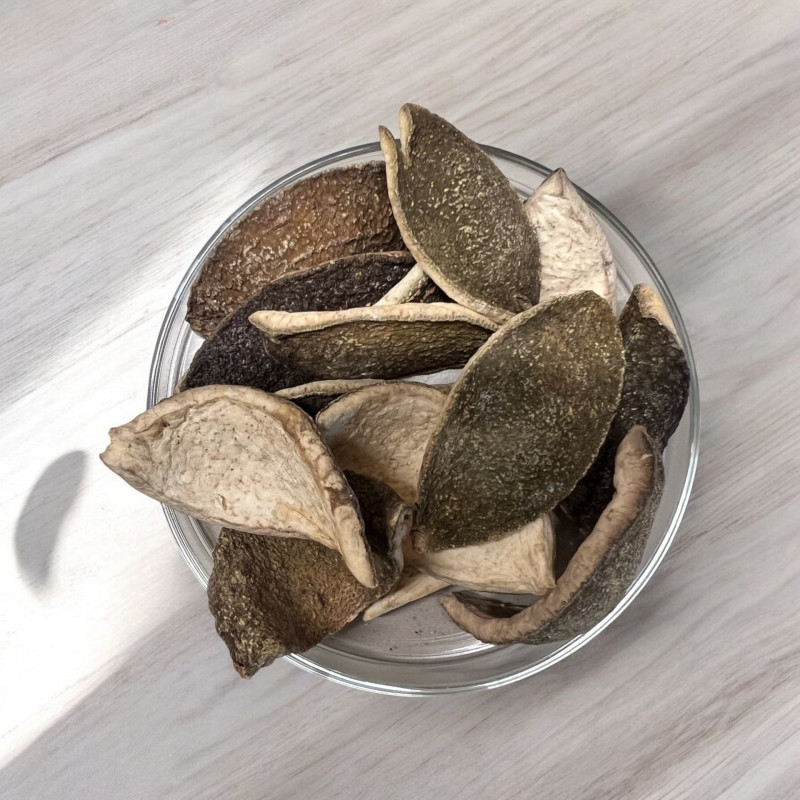
Reference: punch


It has the taste of orange but with a lovely added bitterness, and it's delicious!
With it, you can make aperitifs (notably orange wine), flavor stews, veal dishes, infusions, and even jams.
 Delivery
Delivery
Mondial Relay
 Returns
Returns
See conditions
 Payments
Payments
100% secure
Uses in Cooking and Beyond:
Bitter orange peels are used in cooked dishes, liqueurs, and spirits, but also in distillation for perfume making. The flowers are used to make orange blossom water, which is used to flavor cakes, and the leaves are also used in infusions.
Our bitter orange peels are rarely orange in color because, like all their counterparts, it's the cold that turns them orange (before arriving on the shelves, sweet oranges, like mandarins, undergo refrigeration if necessary to obtain the color we're familiar with!). If the fruits are not exposed to the cold, their peel remains green!
In cooking, bitter orange peels give a delicious flavor to meat stews, veal blanquette, and many other veal dishes, as their aroma harmonizes particularly well with veal. You can macerate them in the dish during cooking.
They also allow you to make orange wines, liqueurs, and aperitifs. In fact, they are part of our punch mix and our mulled wine mix. They are also delicious for “cutting” the very sweet taste of certain jams (notably apricot), where they are also macerated during cooking, though not necessarily left in when potting.
Chopped into small pieces, you can also add them to tea or an infusion.
Who am I?
Origin: Haiti
Scientific name: Citrus aurantium
Common names: Seville orange, sour orange, zhi shi
Consuming bitter orange peel is said to stimulate appetite and soothe nervous individuals.
These bitter orange peels come from a beautiful tropical shrub native to Southeast Asia, the Seville orange tree. The tree belongs to the Rutaceae family and reaches 5 to 8 meters in height. Its foliage is shiny and evergreen, and its white flowers have an extremely pleasant sweet scent. Its fruit resembles a small orange but is very bitter. It is harvested from July to September. In the warm countries where it originates and is often cultivated, the fruit's peel remains green because it's the cold that turns citrus fruits orange.
Since the 12th century, the tree has been cultivated in the Mediterranean basin, where, due to the cooler climate compared to its native region, the fruits naturally turn orange.
In the countries that are the largest producers (South Africa, California, South America), they are harvested from April to October.
Data sheet
 Yves L.
Yves L.
Bon produit
 Georges N.
Georges N.
Si le produit est bon, je n'apprécie pas qu'il soit conditionné par 90 g alors que les recettes sont toujours par 100 g
Merci pour votre retour ! Comme nous vous l'avons déjà indiqué, n'hésitez pas à nous contacter directement lors de votre prochaine commande. Nous serons ravis de nous adapter et de vous proposer le conditionnement le plus adapté à vos besoins pour que vos recettes soient parfaitement ajustées. Votre satisfaction est notre priorité, et nous sommes toujours à l'écoute pour répondre à vos attentes. À très bientôt sur Epiciane !
 Marja J.
Marja J.
??

 Yves L.
Yves L.
Bon produit
 Georges N.
Georges N.
Si le produit est bon, je n'apprécie pas qu'il soit conditionné par 90 g alors que les recettes sont toujours par 100 g
Merci pour votre retour ! Comme nous vous l'avons déjà indiqué, n'hésitez pas à nous contacter directement lors de votre prochaine commande. Nous serons ravis de nous adapter et de vous proposer le conditionnement le plus adapté à vos besoins pour que vos recettes soient parfaitement ajustées. Votre satisfaction est notre priorité, et nous sommes toujours à l'écoute pour répondre à vos attentes. À très bientôt sur Epiciane !
 Marja J.
Marja J.
??

Reference: punch
Reference: vinchaud
Reference: ecorceorangeamere
Reference: ecorceorangeamere
Reference: hypocras
Reference: vermouth
Reference: 2071570
Reference: 3N7137901
Reference: 20731803
Reference: badianeE
Reference: 9N7669901
Reference: punch
Reference: 2M6273801
Reference: EPI2301010
Reference: baieroseE
Reference: vinchaud
Reference: ecorcecitronH
Reference: gentiane
Reference: 10N7738802

It has the taste of orange but with a lovely added bitterness, and it's delicious!
With it, you can make aperitifs (notably orange wine), flavor stews, veal dishes, infusions, and even jams.